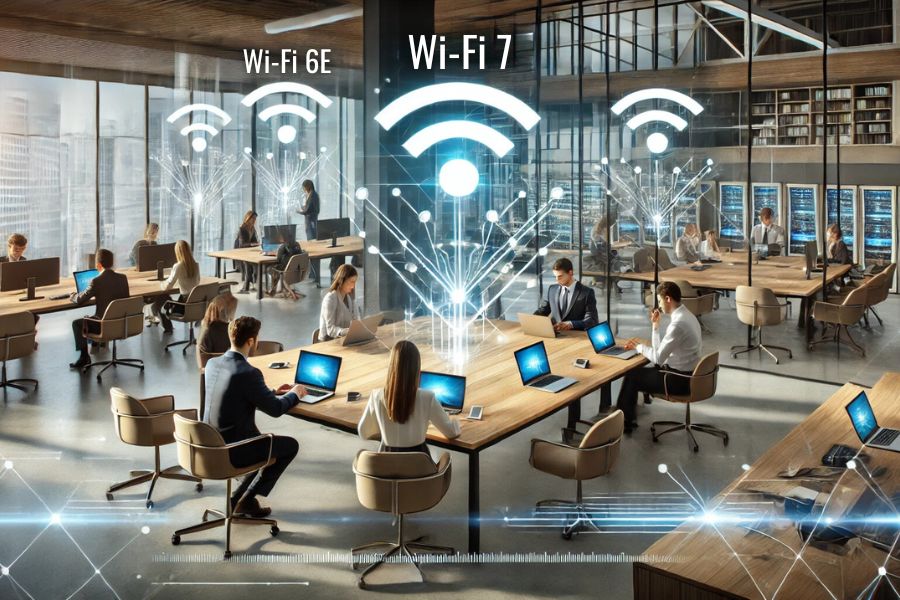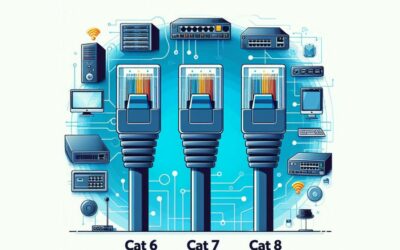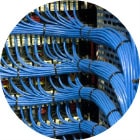What is Wi-Fi 6E?
Wi-Fi 6E is an expansion of Wi-Fi 6, with one key difference: it opens up a whole new band of spectrum at 6 GHz, which brings higher capacity and less interference than previous standards.
Think of it like getting access to a new highway when the main one is packed. This extra space can be a game-changer, especially in high-density environments like offices with multiple devices streaming data simultaneously.
And What About Wi-Fi 7?
Wi-Fi 7, the next generation, is expected to launch in 2024 and will offer even faster speeds—potentially up to 40 Gbps—and ultra-low latency. This speed boost will support bandwidth-hungry applications like 8K streaming, AR/VR, and the increasingly complex IoT (Internet of Things) environments that businesses are adopting.
Pros of Upgrading to Wi-Fi 6E or Wi-Fi 7
1. Higher Speeds and Greater Capacity
- Benefit: With Wi-Fi 6E, you’re looking at a potential increase in speed and device capacity, and with Wi-Fi 7, speeds could reach up to four times that of Wi-Fi 6! If your business struggles with network congestion, especially during peak hours, these upgrades can alleviate bottlenecks and boost overall productivity.
- Real-world example: An office full of employees trying to join a video call, download large files, or use cloud applications all at once will benefit greatly from the enhanced capacity these newer standards provide.
2. Reduced Network Interference
- Benefit: Wi-Fi 6E’s 6 GHz band is still fairly new and less crowded, which means less interference from other Wi-Fi networks and Bluetooth devices. For businesses with a lot of tech and devices in one area, this can make a significant difference in maintaining consistent, reliable connectivity.
- Real-world example: Retail stores that use smart security systems, payment systems, and IoT devices for tracking inventory will see fewer disruptions from network interference.
3. Future-Proofing Your Business
- Benefit: Wi-Fi 7 is designed with emerging technologies in mind, including virtual and augmented reality, which are becoming more common in industries like healthcare, real estate, and even retail. By upgrading, your business is set to handle these trends without constantly needing new infrastructure updates.
- Real-world example: Imagine a real estate firm that wants to offer immersive 3D tours using VR. Wi-Fi 7’s low latency would make these experiences smoother and more accessible without requiring additional hardware adjustments down the line.
Cons of Upgrading to Wi-Fi 6E or Wi-Fi 7
1. Higher Initial Costs
- Downside: Let’s be honest—upgrading isn’t cheap. Wi-Fi 6E and Wi-Fi 7 routers and compatible devices are more expensive than older technology. It’s an investment, so it’s important to assess if the benefits justify the cost for your business right now.
- Consideration: For smaller businesses or those with minimal connectivity needs, this may be an expense better deferred until Wi-Fi 7 becomes more established and prices come down.
2. Device Compatibility
- Downside: Not all devices can take advantage of Wi-Fi 6E or Wi-Fi 7 yet. You’ll need compatible devices to reap the full benefits, which might require replacing older equipment, adding to the cost.
- Consideration: If your business relies heavily on older tech that doesn’t need high-speed connectivity, the added expense may not be immediately beneficial.
3. Installation Complexity
- Downside: Setting up a Wi-Fi 6E or Wi-Fi 7 network can be more complex than traditional setups, especially if you want to optimize performance and security across a large area.
- Consideration: For larger office spaces, hiring an IT professional or cabling company to set up your new network can ensure you’re getting the most out of the upgrade, but it adds another cost to consider.
So, Is It Time to Upgrade?
Here are some questions to help you decide:
- Do you consistently experience network congestion or slow speeds? If you frequently deal with buffering, dropped calls, or delayed loading times, Wi-Fi 6E or Wi-Fi 7 could provide the boost you need.
- Are you planning to scale your business’s tech needs? If you’re integrating IoT devices, virtual reality, or other data-intensive applications, investing now can future-proof your business.
- Do you have the budget for an upgrade? Consider both the immediate costs and the potential long-term savings from improved productivity and fewer connectivity issues.
For many businesses, Wi-Fi 6E offers a solid improvement in speed and capacity that can pay off right away, especially in high-density or high-tech environments. For others, waiting for Wi-Fi 7 to become more widely available may be the more economical choice.









